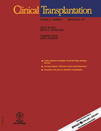Transurethral injection therapy with carbon-coated beads (Durasphere®) for treatment of recurrent pyelonephritis in kidney transplant patients with vesico-ureteral reflux to the allograft
Abstract
Antonopoulos IM, Piovesan AC, Falci R Jr, Kanashiro H, Saito FJA, Nahas WC. Transurethral injection therapy with carbon-coated beads (Durasphere®) for treatment of recurrent pyelonephritis in kidney transplant patients with vesico-ureteral reflux to the allograft. Clin Transplant 2011: 25: 329–333. © 2010 John Wiley & Sons A/S.
Abstract: Introduction and objectives: Recurrent transplant pyelonephritis (RTP) secondary to vesico-ureteral reflux (VUR) to the transplant kidney (KTx) remains a significant cause of infectious complications with impact on patient and graft outcomes. Our objective was to verify the safety and efficacy of transurethral injection of Durasphere® to relieve RTP secondary to VUR after renal transplantation.
Patients and methods: Between June 2004 and July 2008, eight patients with RTP (defined as two or more episodes of pyelonephritis after transplantation) and VUR to the KTx were treated with subureteral injections of Durasphere®. The mean age at surgery was 38.8 ± 13.8 yr (23–65). The patients were followed regularly every six months. The mean interval between the KTx and the treatment was 76 ± 74.1 (10–238 months). The mean follow-up was 22.3 ± 16.1 months (8–57 months).
Results: Six patients (75%) were free of pyelonephritis during a mean period of follow-up of 23.2 ± 17.1 months (8–57 months). Two of them had no VUR and four cases presented with G II VUR (pre-operative G IV three cases and one case G III). In one case, symptomatic recurrent cystitis made a second treatment necessary. This patient remained free of infections for three yr after the first treatment and for 18 months after the second treatment. Of the remaining two patients, one had six episodes of RTP before treatment in a period of three yr and only two episodes after treatment in two yr of follow-up. The last case had a new episode of pyelonephritis five months after treatment.
Conclusions: Transurethral injection therapy with Durasphere® is a safe and effective minimally invasive treatment option for KTx patients with recurrent RTP. A second treatment seems to be necessary in some cases.




